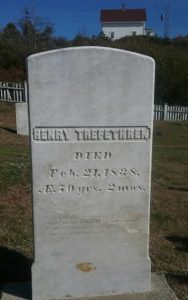
Island Hopping: The Interconnected Families of Monhegan, House, and Peaks Islands
Before highways connected towns and cities together, the easiest way to move around coastal Maine was by boat. Island communities were in some ways less isolated than they are today. Islanders, many who made their living from the maritime trades, moved from island to island routinely. Peaks, House, and Monhegan Islands were linked by several island families.
 Gravestone of Henry Trefethen (1767-1838) on Monhegan Island
Gravestone of Henry Trefethen (1767-1838) on Monhegan Island
In the 1790s, siblings from the Trefethen and Sterling (sometimes known as Starling) families intermarried and lived as farmers and mariners on Monhegan Island, in what is now Lincoln County in mid-coast Maine. In 1826, Henry Trefethen (there were a lot of Henrys in the family; this one lived from 1767-1838) built a grand house on Monhegan called “The Influence,” still admired as a landmark today.
 The Influence, Monhegan Island home built by Henry Trefethen
The Influence, Monhegan Island home built by Henry Trefethen
Henry’s son (1797-1880), also named Henry, left Monhegan with his wife Mary (nicknamed Polly) in 1823. They settled on House Island in Portland Harbor, a short distance from Peaks Island, where they shared a residence with their Sterling cousins, who had also relocated from Monhegan. They operated a successful fish drying business on House, where they processed up to a quarter million pounds of fish a year.
 House Island, circa 1895
House Island, circa 1895
In the mid 19th century, the story shifts to Peaks Island. In 1843, Henry and Polly bought almost 25% of the land on Peaks, where the Sterling family had already purchased many acres of land. Sterling Street on Peaks is named after them. The Trefethen Homestead was built in 1844 and still stands, just up the hill from the landing that bore their name. “Trefethen, Maine” was an official postal code, and the area had its own post office for a time.
 Shady Road, Trefethen, Maine 1890
Shady Road, Trefethen, Maine 1890
The Sterling and Trefethen families shaped each of the islands they settled on, and built homes, wharves, and streets that are familiar to us today. The Fifth Maine Museum is proud to have many Trefethen and Sterling family heirlooms in our collection, including an eighteenth century desk owned by Henry Trefethen. The desk was generously donated by Trefethen descendent, Charles Blackman, and is on exhibit on the second floor of the museum.
 Jessie Trefethen (1883-1978) and her mother Elizabeth Mank Trefethen (1847-1943)
Jessie Trefethen (1883-1978) and her mother Elizabeth Mank Trefethen (1847-1943)
on the steps of the Trefethen Homestead on Peaks Island, circa 1940
